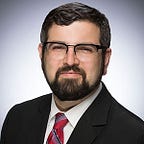Take what you have, build what you need — Innovation in higher ed
This is adapted from our Lumina Foundation podcast, “Today’s Students / Tomorrow’s Talent.” Click the video below to see the show, or if you’re on the go, catch us on iTunes or wherever audio podcasts are found. To see more episodes, please go to the show’s website.
We often talk about the importance of innovation in education, but we often lack a clear definition of the concept.
The definitions provided by my three guests on the 26th episode of the Lumina Foundation podcast “Today’s Students/Tomorrow’s Talent” are all over the map and extend well beyond technology. And that appears to be a good thing, because we’re talking about innovations in areas as wide-ranging as HyFlex courses, allocating classroom space, and making college affordable.
Youngbok Hong is a professor of visual communication design and director of the graduate program of Design Thinking and Design Leadership at Indiana University-Purdue University Indianapolis. She said that at IUPUI, which has 17 distinct schools and two colleges, you’ll find radically different definitions of innovation based on the needs of the students, faculty, and administration.
The common thread is that innovation ultimately means meeting students where they are and finding a way for them to succeed. Student perspectives and needs create a foundation from which value can be defined.
Veteran journalist Paul Fain, who writes “The Job,” a newsletter about connections between education and the American workforce, said obvious examples of innovation can be found in giant-scaled operations such as Western Governors University, Southern New Hampshire University and Arizona State University, which have blazed trails in online education.
But “the most promising innovations are small — an employer in a community working with a non-profit organization and community college to create a pathway for 40–50 jobs,” Fain said. “If we see a big change in the way students are served, it’s probably going to be that — through hundreds and thousands of experiments that work.”
Dr. David Wilson, president of Morgan State University, an HBCU in Baltimore, said you can see innovation on his campus in the $6 million-plus classroom upgrades that improve both the in-class and online experience for students and faculty, and through the addition of 18 new interdisciplinary degrees this May.
The new degrees — eight bachelor’s, six master’s, and four doctoral — were “the result of our understanding that we have to pull together a number of disciplines and understand the skills that are developed at the intersection of these disciplines,” he said.
Wilson said he expects great change in higher education over the next five to seven years, with institutions become more nimble. There will be more public-private partnerships and more discussions with employers about the skills they hope to see in graduates. And there will be a “huge menu” of new and different degrees and more interdisciplinary degrees that combine skills such as tech-savviness, global and cultural competence, and the ability to engage in critical thinking and work in teams.
Wilson, who grew up in Alabama in abject poverty and made his own toys as a child, said innovation doesn’t necessarily require a lot of money. It requires creativity.
“How do you take what you have and make what you need?” he said.
“We know we don’t have everything that you will find on every other campus. But how do we take what we have and use our creativity, understand the needs of our students, the needs of our larger community, and then make what we need?”
In so doing, he said, the school must create a system of excellence for students so “once they embrace it — once they taste it — they’re ready to dance on the world stage with the best of them: anyplace, anytime, anywhere.”
Dakota Pawlicki leads Talent Hubs work at CivicLab. He was previously a strategy officer at Lumina Foundation leading efforts focused on community mobilization and workforce education.
